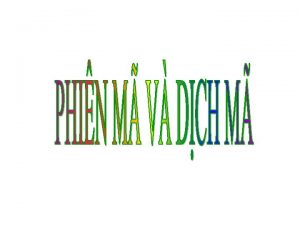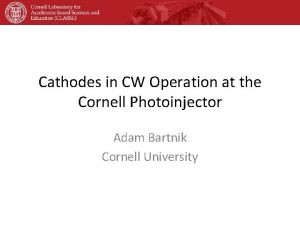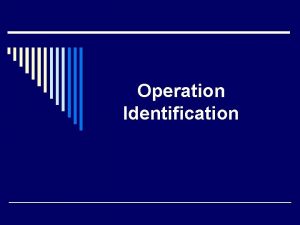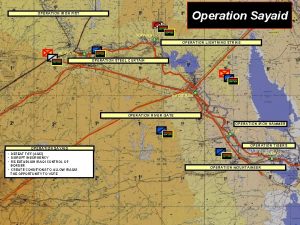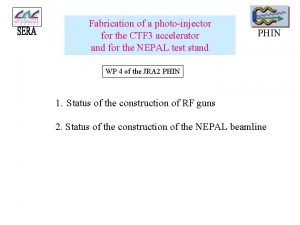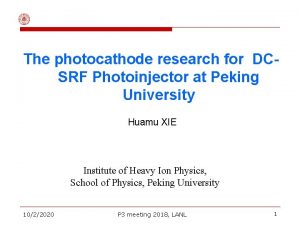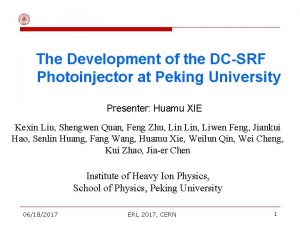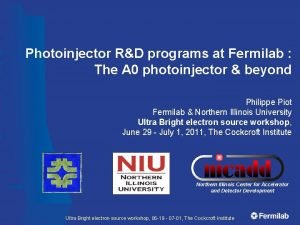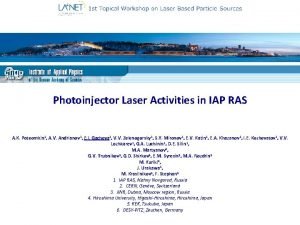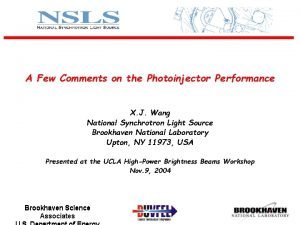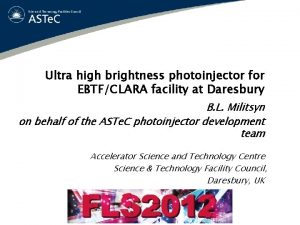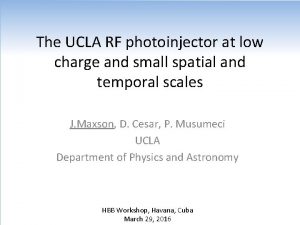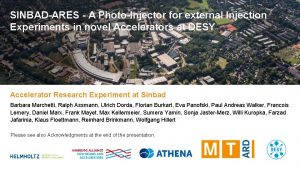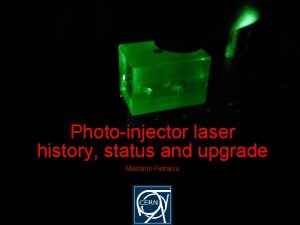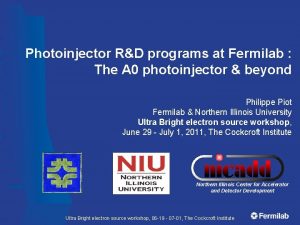Operation of the HighCharge PHIN RF Photoinjector with






















- Slides: 22

Operation of the High-Charge PHIN RF Photoinjector with Cs 3 Sb Cathodes Christoph Hessler, Eric Chevallay, Steffen Doebert, Valentin Fedosseev (CERN) 8 October 2012 Photocathode Physics for Photoinjectors Workshop 2012 Cornell University

Introduction § The drive beam of the CLIC test facility (CTF 3) is currently being produced using a thermionic electron gun. A sub-harmonic bunching system produces the needed time structure for the beam combination scheme. § However, parasitic satellite bunches are generated with this setup, which cause beam losses and radiation issues. § To overcome these limitations the photoinjector PHIN was constructed at an off-line test stand to study its feasibility as an alternative to the CTF 3 thermionic electron gun. § Satellite-free beam production at PHIN has been demonstrated in 2011. § Although PHIN was designed for CTF 3 and not for CLIC, the focus of the PHIN studies has now shifted towards feasibility studies for the CLIC drive beam. 8 October 2012 C. Hessler, E. Chevallay, S. Doebert, V. Fedosseev 2

PHIN and CLIC Parameters Parameter PHIN CLIC Charge / bunch (n. C) 2. 3 8. 4 Macro pulse length (μs) 1. 2 140 Bunch spacing (ns) 0. 66 2. 0 Bunch rep. rate (GHz) 1. 5 0. 5 Number of bunches / macro pulse 1800 70000 Macro pulse rep. rate (Hz) 5 50 Charge / macro pulse (μC) 4. 1 590 Beam current / macro pulse (A) 3. 4 4. 2 Bunch length (ps) 10 10 Charge stability <0. 25% <0. 1% Cathode lifetime (h) at QE > 3% (Cs 2 Te) >50 >150 Norm. emittance (μm) <25 <100 Main issues: - Long cathode lifetimes with high bunch and average charges - Laser system for CLIC parameters (harmonics generation, 50 Hz operation) 8 October 2012 C. Hessler, E. Chevallay, S. Doebert, V. Fedosseev 3

PHIN Photoinjector and CTF 3 FCT: Fast current transformer VM: Vacuum mirror SM: Steering magnet BPM: Beam position monitor MSM: Multi-slit Mask OTR: Optical transition radiation screen MTV: Gated cameras SD: Segmented dump FC: Faraday cup 8 October 2012 C. Hessler, E. Chevallay, S. Doebert, V. Fedosseev 4

Laser System To CALIFES photoinjector 4ω Harmonics 200μJ in 100 ns (=1. 3μJ / laser pulse) 2ω 3 -pass amplifier 1. 5 GHz Synched oscillator Cw preamplifier 10 W Cooling Booster 320 m. W amplifier 3 -pass amplifier 3. 5 k. W 7. 8 k. W 2 -pass 8. 3 k. W 2ω 14. 8 m. J in 1. 2μs amplifier Harmonics test stand High. Q front end AMP 1 and AMP 2 3. 6 k. W 4. 67 m. J in 1. 2μs 4ω 1. 25 k. W 1. 5 m. J in 1. 2μs (=800 n. J / laser pulse) To PHIN Photoinjector M. Petrarca et al. , “Study of the Powerful Nd: YLF Laser Amplifiers for the CTF 3 Photoinjectors”, IEEE J. Quant. Electr. 47 (2011), p. 306. 8 October 2012 C. Hessler, E. Chevallay, S. Doebert, V. Fedosseev 5

Photocathode Production § § Co-evaporation of Cs and Te/Sb Monitoring of each component by a separate microbalance (other component is shielded by a mask) DC gun + diagnostic beam line for measuring the photocathode properties Achieved QE: ~20% (Cs 2 Te), 4. 4% (Cs 3 Sb) Laser beam Shutter Te/Sb microbalance Photocathode plug Cs microbalance Evaporators Te/Sb evaporator Masks Cs dispenser E. Chevallay, “Experimental Results at the CERN Photoemission Laboratory with Co-deposition Photocathodes in the Frame of the CLIC Studies”, CTF 3 Note 104, submitted 8 October 2012 C. Hessler, E. Chevallay, S. Doebert, V. Fedosseev 6

Co-deposition Cs 3 Sb Photocathodes § § § After stopping the evaporation, the QE first continues to increase during beam production. Reason for this behavior still unclear, maybe due to re-organization of Cs and Sb atoms. Maximum QE achieved: 4. 4% Continuous beam operation 8 October 2012 C. Hessler, E. Chevallay, S. Doebert, V. Fedosseev 7

Lifetime studies of Cs 3 Sb cathodes with green light § § § Excellent lifetimes obtained, much better than expected. Long-time operation over 10 days with one cathode! Operation of 1. 2 µs long trains yield similar lifetime as for short trains. 2. 3 n. C, 350 ns 1/e lifetime 168 h 8 October 2012 C. Hessler, E. Chevallay, S. Doebert, V. Fedosseev 2. 3 n. C, 1200 ns 1/e lifetime 135 h 8

Lifetime Cs 3 Sb vs. Cs 2 Te Cathodes § § § Comparison with earlier lifetime measurements of Cs 2 Te cathodes. Lifetimes are similar and within CLIC specifications. For Cs 3 Sb a factor 6 less of QE is needed as for Cs 2 Te cathodes, due to the different wavelength and the absence of 4 th harmonics conversion stage Cathode #189 (Cs 3 Sb) Cathode #185 (Cs 2 Te) 2. 3 n. C, 350 ns 1/e lifetime 168 h (corresponds to 270 h above 0. 5% QE) 8 October 2012 2. 3 n. C, 350 ns (corresponds to 300 h above 3% QE) C. Hessler, E. Chevallay, S. Doebert, V. Fedosseev 9

Impact of Vacuum on Cs 3 Sb Cathode Lifetime § § § Comparison with earlier measurements of Cs 3 Sb cathodes with UV light and worse vacuum conditions (same beam parameters). Lifetime has drastically improved from 26 to 185 h. Improved vacuum condition due to activation of NEG chamber around the gun. March 2012 March 2011 1/e lifetime 26 h 1 n. C, 800 ns 1/e lifetime 185 h 1 n. C, 800 ns 4 e-9 mbar 7 e-10 mbar 8 October 2012 C. Hessler, E. Chevallay, S. Doebert, V. Fedosseev 10

Impact of Vacuum on Cs 2 Te Cathode Lifetime Comparison of lifetime measurements with same beam properties but different vacuum conditions: Cathode #185 8 October 2012 § Substantial improvement of dynamic vacuum level has resulted in drastic increase of 1/e lifetime from 38 to 250 h. § Corresponds to total cathode lifetime of 300 h above 3% QE. C. Hessler, E. Chevallay, S. Doebert, V. Fedosseev 11

Summary and Outlook § § § § § Cs 3 Sb photocathodes successfully operated at PHIN RF photoinjector with green light. Similar lifetimes obtained as for Cs 2 Te cathodes. Good candidate material for further studies Good vacuum is mandatory for a good lifetime. Cathode production process (co-evaporation) seems to be important for obtaining good lifetimes for Cs 3 Sb cathodes. Continue studies on Cs 3 Sb cathodes with green light at PHIN. Increase train length to maximum klystron pulse length of 5 µs Further improvement of vacuum in PHIN planned (additional NEG pump). Integrated charge studies with Cs 3 Sb cathodes in DC gun of photoemission lab Final proof of feasibility of a photoinjector for CLIC drive beam can only be achieved with a 1 GHz RF gun specially designed for the CLIC requirements. 8 October 2012 C. Hessler, E. Chevallay, S. Doebert, V. Fedosseev 12

8 October 2012 C. Hessler, E. Chevallay, S. Doebert, V. Fedosseev 13

CLIC 8 October 2012 C. Hessler, E. Chevallay, S. Doebert, V. Fedosseev 14

Laser in IR Laser in UV Electrons PHIN and CLIC Parameters 8 October 2012 charge/bunch (n. C) train length (ns) bunch spacing(ns) bunch length (ps) bunch rep rate (GHz) number of bunches machine rep rate (Hz) margine for the laser charge stability Cathode lifetime (h) at QE > 3% laser wavelegth (nm) energy/micropulse on cathode (n. J) energy/micropulse laserroom (n. J) energy/macrop. laserroom (u. J) mean power (k. W) average power at cathode wavelength(W) micro/macropulse stability conversion efficiency energy/macropulse in IR (m. J) energy/micropulse in IR (u. J) mean power in IR (k. W) average power on second harmonic (W) average power in final amplifier (W) DRIVE beam PHIN CLIC 2. 3 8. 4 1200 140371 0. 666 1. 992 10 10 1. 5 0. 5 1802 70467 5 100 1. 5 2. 9 <0. 25% <0. 1% >50 >150 262 363 1988 544 5765 9. 8 E+02 4. 1 E+05 0. 8 2. 9 0. 005 41 1. 30% <0. 1% 0. 1 9. 8 4062. 2 5. 4 57. 6 8. 2 28. 9 0. 49 406 9 608 C. Hessler, E. Chevallay, S. Doebert, V. Fedosseev 15

Improvement of PHIN Vacuum System Layout PHIN gun: Laser beam Electron beam Photo cathode Plan to improve vacuum in two steps: § Activation of existing NEG coated chamber around the gun § Activation of existing NEG coating in beam line and installation of additional NEG pump. 20 cm 8 October 2012 C. Hessler, E. Chevallay, S. Doebert, V. Fedosseev 16

Impact of Bunch Charge on Vacuum vs. bunch charge § Vacuum can be maintained up to nominal bunch charge of PHIN of 2. 3 n. C. § Pressure increase above nominal bunch charge probably due to losses inside gun. § A 1 GHz gun specially designed for CLIC might be able to maintain the vacuum up to a higher bunch charge due to larger apertures. 8 October 2012 C. Hessler, E. Chevallay, S. Doebert, V. Fedosseev 17

Impact of Train Length on Vacuum vs. train-length Corresponding beam losses Between FCT and Faraday cup Bunch charge 2. 3 n. C § Vacuum correlated to beam losses in the beam line § When beam is optimized for good transport, the vacuum can be maintained with increasing train length 8 October 2012 C. Hessler, E. Chevallay, S. Doebert, V. Fedosseev 18

High Charge Production (Cs 2 Te) § § Charge vs. laser energy scan with 50 ns long trains Linear response up to 5 n. C Record bunch charge of 9. 2 n. C above CLIC requirements! Close to theoretical limit of Qmax=9. 47 n. C for a beam size of 1. 8 mm s x 1. 25 mm s 9. 2 n. C! Cathode #185 Cs 2 Te 8 October 2012 C. Hessler, E. Chevallay, S. Doebert, V. Fedosseev 19

Lifetime Studies of Cs 2 Te Cathodes § Cathode lifetime vs. vacuum § Correlation between lifetime and vacuum. § In high e-9 mbar/ low e-8 mbar < 50 h lifetime was measured. § When vacuum is kept at low e-9 mbar lifetime is within specification. Cathode #182 8 October 2012 C. Hessler, E. Chevallay, S. Doebert, V. Fedosseev 20

Phase Coding Demonstration § Motivation § CTF 3/CLIC drive beam requires several fast 180 degree phase-switches for beam combination. § With currently used thermionic DC gun and sub-harmonic bunching satellites are produced, which could cause radiation problems. § Aim to provide an alternative satellite-free solution using laser phasecoding based on fiber-modulator technology and an RF photo-injector. § Setup: M. Csatari Divall et al. , “Fast phase switching within the bunch train of the PHIN photo-injector at CERN using fiber-optic modulators on the drive laser”, Nucl. Instr. And Meth. A 659 (2011) p. 1. 8 October 2012 C. Hessler, E. Chevallay, S. Doebert, V. Fedosseev 21

Phase Coding Demonstration § Results: § Streak camera measurements of Cerenkov light switching time < 300 ps Satellites <0. 1% § Beam observation on fast current transformer: No beam degradation due to switching 8 October 2012 C. Hessler, E. Chevallay, S. Doebert, V. Fedosseev 22
 Nguyên nhân của sự mỏi cơ sinh 8
Nguyên nhân của sự mỏi cơ sinh 8 Trời xanh đây là của chúng ta thể thơ
Trời xanh đây là của chúng ta thể thơ Chó sói
Chó sói Thiếu nhi thế giới liên hoan
Thiếu nhi thế giới liên hoan Vẽ hình chiếu vuông góc của vật thể sau
Vẽ hình chiếu vuông góc của vật thể sau Một số thể thơ truyền thống
Một số thể thơ truyền thống Thế nào là hệ số cao nhất
Thế nào là hệ số cao nhất Hệ hô hấp
Hệ hô hấp Tư thế ngồi viết
Tư thế ngồi viết Thế nào là số nguyên tố
Thế nào là số nguyên tố đặc điểm cơ thể của người tối cổ
đặc điểm cơ thể của người tối cổ Các châu lục và đại dương trên thế giới
Các châu lục và đại dương trên thế giới Mật thư anh em như thể tay chân
Mật thư anh em như thể tay chân Chụp phim tư thế worms-breton
Chụp phim tư thế worms-breton ưu thế lai là gì
ưu thế lai là gì Thẻ vin
Thẻ vin Bàn tay mà dây bẩn
Bàn tay mà dây bẩn Các châu lục và đại dương trên thế giới
Các châu lục và đại dương trên thế giới Bổ thể
Bổ thể Từ ngữ thể hiện lòng nhân hậu
Từ ngữ thể hiện lòng nhân hậu Tư thế ngồi viết
Tư thế ngồi viết V cc
V cc






















